
About UsThe Numismatic Bibliomania Society is a non-profit organization promoting numismatic literature. For more information please see our web site at coinbooks.org SubscriptionsThose wishing to become new E-Sylum subscribers (or wishing to Unsubscribe) can go to the following web page link MembershipThere is a membership application available on the web site Membership Application To join, print the application and return it with your check to the address printed on the application. Membership is only $15 to addresses in the U.S., $20 for First Class mail, and $25 elsewhere. For those without web access, write to: David M. Sundman, Secretary/TreasurerNumismatic Bibliomania
Society AsylumFor Asylum mailing address changes and other membership questions, contact David at this email address: dsundman@LittletonCoin.com SubmissionsTo submit items for publication in The E-Sylum, just Reply to this message, or write to the Editor at this address: whomren@coinlibrary.com
BUY THE BOOK BEFORE THE COINYou won't regret it! |
- WAYNE'S WORDS: THE E-SYLUM NOVEMBER 23, 2008
- KOLBE JANUARY 10, 2008 NUMISMATIC LITERATURE AUCTION CATALOGUES AVAILABLE
- STOCKLEY SELLS CHARLTON COIN PHOTOGRAPH ARCHIVE
- C4 CONVENTION REPORT: HULL MINT MARKER AND BOWERS COLONIAL BOOK UNVEILED
- NEW BOOK: GOLD COINS OF THE CHARLOTTE MINT (THIRD EDITION) BY DOUGLAS WINTER
- KAGIN SEEKS INPUT FOR 2ND EDITION OF PRIVATE GOLD COINS AND PATTERNS
- ADNA G. WILDE JR. (1920 - 2008)
- MISHLER ANNOUNCES CANDIDACY FOR ANA PRESIDENCY
- DECEMBER 2008 ISSUE OF THE NUMISMATIST PUBLISHED
- QUIZ ANSWER: NAMING THOSE TUNES ON THE DISTRICT OF COLUMBIA SCRIP NOTES
- U.S. MINT IMAGES AT THE PHILADELPHIA RECORD PHOTOGRAPH MORGUE
- WILLARD WIGEN'S TINY SCULPTURES - A NUMISMATIC CONNECTION?
- DEFINITIONS: PREMIUM PLACED ON PRECIOUS METAL POSSESSION
- WHEN THEY LOST CALIFORNIAS BIGGEST GOLD NUGGET
- QUERY: 1907 SAINT-GAUDENS $20 "OMEGA" AND "BROKEN G" COUNTERFEITS SOUGHT
- IS SKYJACKER D.B. COOPER ABOUT TO BE UNMASKED?
- QUERY: MAVERICK SCRIP NOTE OF LAFAYETTE
- QUERY: NUMISMATICALLY SIGNIFICANT CIRCULATION FINDS
- ALAN WEINBERG'S REPORT ON THE NOVEMBER 2008 BALTIMORE COIN SHOW
- ARTICLE RECOUNTS HOMEBOUND JOURNEY OF 1844-0 EAGLE
- NEWSPAPER ARTICLE PROFILES HERITAGE AUCTION GALLERIES
- THIRD-PARTY COIN SLABBING IN EUROPE
- PRESIDENTIAL DOLLARS VENDED FROM U.S. MINT TRUCKS
- PRESIDENT BUSH SURPRISES FOUR WITH PRESIDENTIAL CITIZENS MEDALS
- MUSEUM ACQUIRES MEDAL OF NUMISMATIST SIR JOHN EVANS
- A GREAT YEAR FOR TREASURE HUNTERS
- ANCIENT CELTIC COIN CACHE FOUND IN NETHERLANDS
- HOW TO SPOT A FAKE POUND COIN
- ARGENTINA.S COIN SCARCITY LEADS TO BLACK MARKET COIN TRADE
- UNCERTAIN ECONOMY BOOSTS WORLD MINTS' GOLD PRODUCTION
- HILLARY CLINTON PHOTOGRAPHED IN SHELDON'S HUMAN PHYSIQUE BOOK?
- FEATURED WEB PAGE: CANADIAN COIN, CANCELLED (WAFFLED) BY MISTAKE?
WAYNE'S WORDS: THE E-SYLUM NOVEMBER 23, 2008
 Among our recent subscribers is Gene Wiley.
Welcome aboard! We now have 1,219 subscribers.
Among our recent subscribers is Gene Wiley.
Welcome aboard! We now have 1,219 subscribers.This week's issue is another whopper. As usual, we open with news related to numismatic literature sales and new books, which this week include Dave Bowers' Colonial book and new editions of Winter's Charlotte Mint book and Kagin's Pioneer Gold book.
Last week's musical quiz drew many interesting responses. New queries this week include interesting circulation finds and the "Omega" counterfeits of 1907 Double Eagles. Show reports include Ray Williams on the C4 convention and Alan Weinberg on Baltimore. To learn how someone could manage to lose a fifty-pound gold nugget, read on. Have a great week, everyone!
Wayne Homren
Numismatic Bibliomania Society
KOLBE JANUARY 10, 2008 NUMISMATIC LITERATURE AUCTION CATALOGUES AVAILABLE
The public auction sale of the two libraries is being held on January 10, 2009 at the Waldorf Astoria Hotel in New York City, in conjunction with the New York International Numismatic Convention (NYINC). There are special room rates for convention (and/or auction) attendees but those interested in attending are advised to book their rooms soon. Be sure to mention NYINC for the special rate. A card will be mailed with our catalogues reducing admission for all three days of the convention to $5.00 (normally $10).
STOCKLEY SELLS CHARLTON COIN PHOTOGRAPH ARCHIVE
Numismatic literature dealer Richard Stockley has been offering items from the collection of Mr. James Charlton to customers on his email list. One that I knew would be of particular interest to the right researcher has already found a buyer. -EditorStockley writes:
He can be reached at this email address: rstockley@videotron.ca .
C4 CONVENTION REPORT: HULL MINT MARKER AND BOWERS COLONIAL BOOK UNVEILED
It was a wonderful weekend at C4!!!! Many things happening! There was a dedication of an historic Marker for the site of the Boston Mint (Hull & Sanderson) where NBS member John Adams was significant in convincing the Bostonian Society of the historical importance of the operation, people, events and economics of the site. The Bostonian Society is responsible for the placement of historic markers in the area.
Also, Whitman publications, at the request of Dave Bowers, donated a galley copy of Dave's new book on colonials to C4. This work was on display at the C4 Table for the entire convention and attracted a lot of attention (an understatement). It was sold during our annual auction, where the proceeds would go to C4. IT BROUGHT $10K!!!!!
Tony Terranova was the generous winning bidder! And to top this off, I heard Tony say that the book would be donated to the ANS Library this week! Here is the auction description of the galley that was provided at the auction:
I personally can't wait for this book to become available to the public. It will be a must-have reference for all that enjoy colonial coins, or who think they might enjoy them.
With Bowers' new book (the related new book by Will Nipper (In Yankee Doodle's Pocket), and other new titles on specialized topics (such as Syd Martin's book on The Coinage of William Wood), students of colonial numismatics have never had it so good. And on top of that, 2008 saw a new edition of Eric Newman's Early Paper Money of America. -Editor
NEW BOOK: GOLD COINS OF THE CHARLOTTE MINT (THIRD EDITION) BY DOUGLAS WINTER
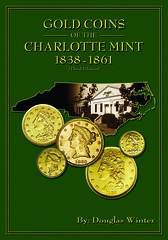 Douglas Winter is regarded today as one of the
leading industry experts in U.S. branch mint gold coins. His newest book,
releasing in December 2008, is the updated and revised edition of Gold
Coins of the Charlotte Mint: 1838-1861. Quoted by Jeff Ambio, author
of the Strategy Guide series, as
Douglas Winter is regarded today as one of the
leading industry experts in U.S. branch mint gold coins. His newest book,
releasing in December 2008, is the updated and revised edition of Gold
Coins of the Charlotte Mint: 1838-1861. Quoted by Jeff Ambio, author
of the Strategy Guide series, as
A significant number of changes and improvements have been implemented into this third edition. Using layout designs similar to his previously released New Orleans and Dahlonega Mint books, this revised edition of the Charlotte Mint book is also easy to follow and more enjoyable to read. High quality full color photos beautifully illustrate every coin and the newly improved die variety section now has outstanding close-up images of many important varieties.
All figures on population, rarity rankings, total values by grade and significant examples have been updated to reflect the latest market information available today, including a complete rarity summary chart at the end of each chapter.
For the historian, two chapters written about the history of the Charlotte Mint by David Ginsburg are included, and finally, Winter.s personal tips and strategies on how to collect C-mint gold coins guide the reader. Whether the collector is looking to buy one or two pieces or to complete a set, Winter.s suggestions offer an invaluable resource no matter what the budget or goal of the collector.
Pre-order this book today from bookstores nationwide, Amazon.com or your local coin shop. Also available from Zyrus Press: PO Box 17810, Irvine, CA 92623. Phone: (888) 622-7823. Web: Stay up-to-date! Visit www.zyruspress.com. E-mail: info@zyruspress.com.
Gold Coins of the Charlotte Mint . 3rd Edition
Published by Zyrus Press, Inc. of Irvine, California (www.zyruspress.com)
Publication Date: December 2008
Binding / Size: Paperback / 7x10
Photos / Illustrations: 150+ full color images
Pages: 196
Suggested Retail Price: $39.95
For more information, or to order from the publisher, see: Gold Coins of the Charlotte Mint: 1838-1861 (http://www.zyruspress.com/goldcoinsofthecharlottemint1838-1861.aspx)
KAGIN SEEKS INPUT FOR 2ND EDITION OF PRIVATE GOLD COINS AND PATTERNS
Our recent discussions of advice for numismatic authors are timely - many of Don's questions are the same ones most numismatic authors must deal with. What do you think, readers? -Editor
Here are a few questions to get your creative juices started. You can also add your own questions. Please feel free to email, call or just chat with us at an upcoming coin show about your ideas.
Whitman publishing has tentatively scheduled publication in 2010; but that really does not give us much time to implement needed changes (especially color plate coins). So please contact us as soon as possible. Your contribution will be noted in the upcoming edition. Thank you. Don
1. Should we change the name of the book to .Pioneer Gold and Patterns of the United States.. Or to another name?
2. Should we include foot(end) notes which will require another 10 or so pages? We left this out of the first edition.
3. Since there will be a number of changes to the pattern section of the book, we tentatively plan to renumber by company as before, allowing for new discoveries and by adding a .P. before each number. Should we also use the P designation for Restrikes and Fantacies, etc. or use separate prefix letters for them? Your thoughts?
4. Do you agree with the chronological die order of the Bechtler coinage? If we decide that, for instance, K7 came before K6 or K9 before K8, do we change the K numbers around (please keep in mind some grading company pop reports and even some tags are keyed into our current grading numbers)?
5. Do you agree with our current edition.s rendering of what is the obverse and reverse die for the Bechtlers? Other references disagree, including one which believes the name Bechtler should be the determining factor for the obverse die.
6. It has been determined that a few pieces should not be in the main section of the book. One, like the USAO #3 is not a separate variety but a tooled coin not available to examine 30 years ago. Should we completely renumber the rest or just leave out this number?
7. Do we completely renumber those series such as USAO to accommodate every die variety such as a .small 7. vs. .Large 7. as does Breen? Should these be new .a. numbers? Or put another way, What should constitute a new number vs. a sub letter e.g. (a) vs. a sub number e.g. [(1)]?
8. In the pattern section we think the latter designation of sub numbers should be for those coins that have been gilt and the subletters for designating either Plain or Reeded Edge. Or should we use subletters just for designating different medals, or both?
9. Many L.E. slugs have missing letters on edges, upside down impressions, or upside down .50. or even clashed dies. How should we designate these, or should we just mention that they exist?
10. Do you believe that the Moffat $20s should be numbered with the USAO pieces or under Moffat or both?
Please keep in mind that while we want this book to be as accurate and comprehensive as possible we want this to be simple to use. That is why we placed companies in alphabetical order within the three gold rushes, rather than chronological order. We also plan to add a chapter on pioneer coins found on shipwrecks; and to add pedigrees under the plate coins. Of course we will also modify rarity figures.
1. NO - do not rename the book. How could it be a second edition if the name changes? The suggestion stems from the fact that items other than coins (such as ingots) are included. I would suggest dealing with this by adding a subtitle to the new edition
2. As Meg Ryan's character in When Harry Met Sally said, I say YES, YES, YES! to footnotes and endnotes. I don't care if a book is a little thicker - it's practically useless without notes on the research that went into it.
6. I'd leave out obsolete numbers and keep the remaining designations intact wherever possible. For thirty years collectors have been using the reference. Drop numbers and add new ones if you have to, but avoid CHANGING old numbers at all costs. -Editor
THE BOOK BAZARRE
ADNA G. WILDE JR. (1920 - 2008)
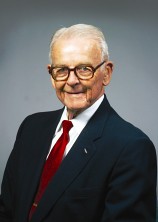 Retired Lt. Col. Adna G. Wilde Jr., former
president, Board member, executive director, treasurer and parliamentarian
of the American Numismatic Association, died on the morning of Nov. 17 in
Colorado Springs. He was 88.
Retired Lt. Col. Adna G. Wilde Jr., former
president, Board member, executive director, treasurer and parliamentarian
of the American Numismatic Association, died on the morning of Nov. 17 in
Colorado Springs. He was 88. "This is a sad time for our Association," ANA President Barry Stuppler said. "Adna will be remembered as one of the most important leaders in our history. Everyone who knew him respected him for his kindness, professionalism, and service to his country. He was the finest gentleman I've ever known, and he will be deeply missed."
A member since 1947 (Life Member 232), Wilde served as executive director from 1968-72, governor from 1973-79, vice president from 1979-81, president from 1981-83 and treasurer from 1983-2008. He received the Farran Zerbe Memorial Award in 1985, the Medal of Merit and Exemplary Service Award in 1991, the Lifetime Achievement Award in 1998, and Presidential Awards in 1994, 1998 and 2008. He received the inaugural award named in his honor, the Adna G. Wilde Jr. Award for Excellence, this October.
Wilde was elected to the ANA Numismatic Hall of Fame in 2002, was named ANA Numismatist of the Year in 2005 and received the Numismatic Ambassador Award from Numismatic News in 1995.
Wilde was born in Vicksburg, Miss., on Oct. 1, 1920, and graduated from The Citadel in 1943. After college, he joined the Army, and was wounded in combat in Italy during World War II. He moved to Colorado Springs in 1945 and served as an officer in the Army, achieving the rank of Lieutenant Colonel before coming to the ANA in 1968.
An accomplished numismatist, he was known most notably for his research of Lesher Referendum dollars and Stone Mountain commemorative half dollars. In his first year as executive director, Wilde and Ed Rochette were instructors for the first Summer Seminar. Enrollment the first year was 17 for the week-long educational event; Summer Seminar has since expanded to two weeks and attracts over 400 students each year.
"The ANA benefited from Adna's expertise for 40 years," said Executive Director Larry Shepherd. "He inspired countless young collectors, and provided a steady hand through good times and bad. His legacy will help guide the Association for generations to come."
To read or leave comments, see: Adna Wilde Memorials (http://www.money.org/ana_custom/adnaWildeMemorial/memorials.cfm)
John and Nancy Wilson write:
This knowledgeable and thoughtful man helped us greatly during our terms of service to ANA. When he recently stepped down as Treasurer and Parliamentarian of the ANA, that was a very sad day for us. No one looked after the ANA in regards to finance and procedure as he did. When Adna talked, Board members listened and almost always agreed with him.
He was a close friend who we always asked for advice in Board meetings as well as other times. He was a leader who served as an example to all of us. His service to our Country in the U. S. Army was also commendable where he achieved the rank of Lt Col. This coin club officer and worker, collector, author, speaker and exhibitor will always be remembered by everyone who crossed his path.
All of our prayers and thoughts to his wife Joan and their family. We have made a donation to ANA in his memory. Rest in Peace Adna, as your passing will be mourned by those of us who loved him so much. With deepest sympathy, John and Nancy Wilson, Volunteers and Life Members of ANA
Howard A. Daniel III writes:
MISHLER ANNOUNCES CANDIDACY FOR ANA PRESIDENCY
 It is my view that the ANA backbone is comprised
of four delivery services for the membership.
It is my view that the ANA backbone is comprised
of four delivery services for the membership.1) The Numismatist
2) The convention venues
3) The Summer Seminar
4) The circulating library
Given the present budget constraints under which the ANA is operating, as it reaches to achieve balanced budget performance (a pursuit which is likely to be complicated by the troubling economic times presently being experienced across the country), it must focus available assets on these four areas of delivery.
Yes, the ANA also offers an impressive Money Museum, but it can provide only a narrow range of service to the membership. And, it also sponsors a range of meritorious educational outreach programs, none of which are self-sustainable financially, with the benefits thereof being difficult, if not impossible to track.
Accordingly, it is my belief that we must concentrate our efforts towards enhancing the service and impact of the four backbone areas indicated. Being chartered as a non-profit, educational organization, whose purpose is to encourage the study and collecting of money in its many forms and related items, these four backbone areas are ideally suited for providing the ANA and the greater hobby community with the greatest bang for its buck.
We must assure that The Numismatist serves the broad spectrum of membership interests, that the convention venues serve to provide maximum exposure for the membership and participating dealers, while exposing the allure of the hobby to the novice and developing higher levels of enthusiasm among those already possessed of a degree of captivation with the hobby, that the Summer Seminar sessions serve to build and broadcast the knowledge quotient level within the hobby, and that the (Dwight N. Manley) circulating library serves to provide the membership with the ultimate research resource to serve their needs.
While I have never been a heavy user of the ANA library myself, I have long been an avid reader of, and advocate of the availability of published numismatic references and literature, going back to my very first .resource,. the 1950 .Annual Catalog. of the Tatham Stamp and Coin Co. that I received when making my first coin purchase.
By the mid-1950s, while still in high school, I had managed to build a personal reference library that probably numbered three or four score books and pamphlets, occupying perhaps three feet of shelf space, a reasonably respectable resource in those days.
By 1958 I was embarking upon a career of contributing to the published resource base of the hobby, beginning with the self-publication of a study with an ungainly title; 1958 United States and Canadian Commemorative Medals and Tokens. After continuing similar annual compilations for the next five years, in 1963 I embarked on a 40 year career in association with Krause Publications, with my reference resource becoming the ever expanding company library.
What I learned in the process is that one can never have too many resources, nor too much information at hand. Thus, I feel that it is vitally important that the ANA continue to develop and expand its circulating library and services to serve the ever expanding needs of its membership and the greater hobby community.
The library must be comprehensive in nature. Its services must change with the times, fully embracing the evolving electronic world. Of paramount importance, it must always be user friendly. As one of the four backbone units of the organization, the ANA library is deserving of appropriate assignment of physical, personnel and financial assets that are in keeping with the significant role it plays in the success of the organization and the greater hobby community.
DECEMBER 2008 ISSUE OF THE NUMISMATIST PUBLISHED
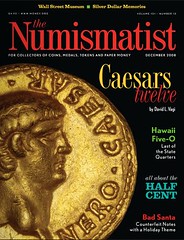 The December 2008 issue of The
Numismatist from the American Numismatic Association has been
published. The lead article is by David Vagi on the coins of the Twelve
Caesars, with fabulous photographs by John Nebel. Also in the issue is an
article by Roger Durand on on counterfeit St. Nick notes, a piece on the
U.S. Half Cent by R. W. Julian, and one by Greg Leslie on the final coin
in the U.S. Mint's state quarter series. Gotta love the title: Hawaii
Five-O.
The December 2008 issue of The
Numismatist from the American Numismatic Association has been
published. The lead article is by David Vagi on the coins of the Twelve
Caesars, with fabulous photographs by John Nebel. Also in the issue is an
article by Roger Durand on on counterfeit St. Nick notes, a piece on the
U.S. Half Cent by R. W. Julian, and one by Greg Leslie on the final coin
in the U.S. Mint's state quarter series. Gotta love the title: Hawaii
Five-O.In his Money Museum column, curator Douglas Mudd discusses the creation of the ANA's new exibit A House Divided: The Money of the Civil War.
One short article I'd like to mention covers a current exhibition at the Denver Art Museum. Houdon from the Louvre displays portrait busts by French sculptor Jean-Antoine Houdon, including two that served as models for U.S. coin designs: George Washington (1786) and Benjamin Franklin (1778).
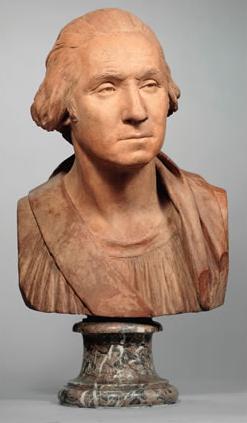
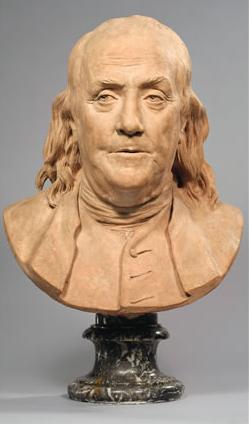
NEWCOMER COLLECTION
George Fuld's recent study, "A Summary of Rarities from the Newcomer Collection," is now available online in its unedited form exclusively at www.money.org. ANA members can read the document by clicking on the magazine cover in the lower left corner of the ANA homepage and accessing the "Members Only" site. (ANA members can request a "Members Only" login name and password by e-mailing membersonly@money.org.)
AUTHORS WANTED
The mission of the ANA's official publication, THE NUMISMATIST, is to educate and provide a forum for the interchange of ideas. It serves as a refreshing review for the experienced collector and as an introduction to essential concepts for the less experienced. The staff and contributing editors of THE NUMISMATIST welcome the opportunity to review well-written, well-conceived articles displaying original, documented research. Collectors/researchers are invited to submit manuscripts on any numismatic topic, in particular United States coins. Authors of articles published in the magazine receive $.12 per word, with bonuses available to those who provide usable photographs or illustrations and/or furnish material for photographic reproduction.
For author guidelines, visit http://www.money.org/AM/Template.cfm?Section=
Home&CONTENTID=5540&TEMPLATE=/CM/HTMLDisplay.cfm or contact Editor-in-Chief Barbara Gregory, 719-482-9831, bgregory@money.org.
GUEST EDITORIALS INVITED
Share your numismatic views with readers of the hobby's premier magazine, THE NUMISMATIST. Direct your 575-625 word "Guest Editorial" to Editor-in-Chief Barbara Gregory, 719-482-9831, bgregory@money.org.
QUIZ ANSWER: NAMING THOSE TUNES ON THE DISTRICT OF COLUMBIA SCRIP NOTES

Len Augsburger was the first to respond. He writes:
Ben Keele writes:
James Higby also responded with those choices. Both are correct, although the true answers are a little more nuanced. Tom Kays had the right idea last Tuesday when we looked at the images of the notes. When others suggested these names for the tunes, he quickly added "actually, the tunes may really be the earlier colonial-era songs these were derived from."
Remember, these notes were printed in 1837, nearly two centuries ago. What we know and recognize today may greatly resemble something known in that era, but a lot of water has gone under the bridge since then.
Ron Haller-Williams of the U.K was the only non-American to offer an answer. He writes:
The one-bit shows "Yankee Doodle" (verse "Father and I ...", not the refrain "Yankee ..."). Some versions have an extra quaver in front so as to be able to give 2 syllables/notes to the word "father"; also, the second group of 4 notes is sometimes a bit higher than shown here.
Arthur Shippee also noticed that something wasn't quite adding up. Regarding the second of the two notes, he writes:
But was it a misprint? Paul Schultz also noted the differences from the modern versions of the songs. He writes:
For Yankee Doodle, the second measure usually has the 4 notes as D F# E A, but this note has D D C# A.
A question for music historians -- are these earlier versions and therefore are they more accurate towards the originals as played many years ago? Were variations in the music common in the era that the bills were printed?
Roger Burdette writes:
E-Sylum readers never cease to amaze me in their breadth of historical knowledge, and I'm humbled in your presence. Several others noted this precursor to The Star Spangled Banner, including Carl Honore, George Huber and Bob Evans. Bob writes:
I found this note thoroughly charming, and I was previously unaware of such a piece. I note that it is written in the key of D major, an arrangement in which only a deep alto or a high (almost heroic) soprano (or tenor) would be able to carry both the lowest and highest notes of the tune successfully. (The high notes in a D major arrangement are well into my falsetto range.) However, it does fit nicely on the treble staff, which is probably why this key was chosen.
The second note illustrated (the 12 1/2 cent) shows a version of the opening of "Yankee Doodle," also very charming.
So what the heck is an Anacreon? When they taught that in school, I must have been daydreaming about the pretty girl in the next row. Forgive me, but according to Wikipedia...
The connection with Anacreon, along with the "drinking" nature of the lyrics, have caused many people to label "The Anacreontic Song" a drinking song. The chorus certainly suggests Bacchanalia with its lyrics "And long may the sons of Anacreon intwine the myrtle of Venus with Bacchus' vine." In all probability some drinking did occur at Society meetings, but the primary purpose of the Society (and its song) was to promote an interest in music.[citation needed] This absence of an official connection to drinking did not keep the song from being associated with alcohol, as it was commonly used as a sobriety test: If you could sing a stanza of the notoriously difficult melody and stay on key, you were sober enough for another round.
For a somewhat educational (and bizarre) YouTube rendition, see: Anacreon (http://www.youtube.com/watch?v=t5JZXTb5ABg)
U.S. MINT IMAGES AT THE PHILADELPHIA RECORD PHOTOGRAPH MORGUE
To access the Philadelphia Record photograph morgue catalog, see: Historical Society of Pennsylvania Online Catalogs (http://www.hsp.org/default.aspx?id=17)
WILLARD WIGEN'S TINY SCULPTURES - A NUMISMATIC CONNECTION?
Dick Johnson writes:Well, the item was submitted by R.V. Dewey and appeared just after his piece on what he believes to be hidden images engraved on a coin by James Longacre. I believe R.V. meant to show nonbelievers that yes, artists can and do create artwork on an incredibly small scale. That does nothing to prove that Longacre indeed created microimages on coins, of course, but that's one connection to numismatics.
The other connection was mentioned in my introduction - the previous week we'd discussed the "World's Smallest Engraving" (Lord's Prayer on the head of a pin) which wasn't suggested by R.V. but serendipitously appeared that week on the internet. I thought the images were phenomenal and would be appreciated by our readers. These take tiny two-dimensional engraving to the next level - three dimensional sculptures.
I was blown away by the boxing ring on the head of a match. Wigen has developed a unique talent, and must be one of the most disciplined and patient beings on the planet.
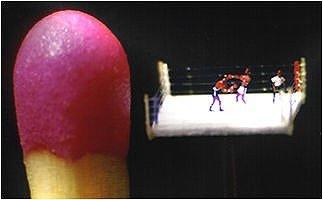
To read the earlier E-Asylum article, see: WILLARD WIGEN: THE WORLD'S TINIEST SCULPTURES (http://www.coinbooks.org/esylum_v11n46a21.html)
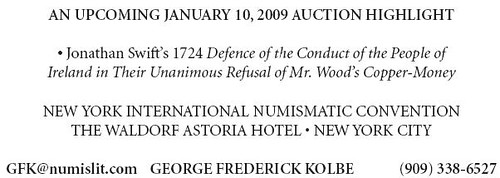
DEFINITIONS: PREMIUM PLACED ON PRECIOUS METAL POSSESSION
Last week Tom Kays asked, "Is there a formal name for the premium placed on precious metal possession?" Tom noted the difference between futures prices paid for silver contracts vs actual delivery and possession of the metal. Dick Johnson writes:Private mints must also pay a processing fee from metal suppliers. It they want delivery of blanks of prescribed gauge and diameter instead of sheets or strips they must also pay a blanking fee.
Interestingly there is a coin word for just the opposite of this meaning, the antonym is agio -- a deduction from the face value of a precious metal coin because it is worn. When coins of gold or silver were valued for a transaction as in international trade -- irrespective of what country or authority issued them -- they were weighed to determine the exact value of the metal. No fiat coins were accepted then.
WHEN THEY LOST CALIFORNIAS BIGGEST GOLD NUGGET
When Willard & Smith returned from buying supplies in Oroville, and after their initial surprise wore off, the three partners decided to sell the nugget. Weatherbee and Wright hitched up an old buckboard in the early hours of the morning on April 18th, and headed for Oroville, twenty-five miles away.
The rickety old buckboard jogged and bounced over rocks along the rutted road. When they finally arrived in Oroville, to their horror they discovered the gold nugget was gone.
In a panic Willard and Wright jumped back into the wagon and retraced their route. More and an hour later they came around a curve and in the road was the burlap sack with the giant nugget in it. Breathing a sigh of relief, they grabbed up the nugget and returned to Oroville.
The immense nugget was shipped from Oroville to the mint in San Francisco and melted down.
This article first appeared in the August 1990 issue of .True West. magazine. Since it appeared, I have talked to many history buffs, and no one had ever heard of this particular happening. I have tried to contact the author, Richard Bauman, but as yet have been unsuccessful. If anyone can supply us with additional information concerning this event, we would be most grateful.
QUERY: 1907 SAINT-GAUDENS $20 "OMEGA" AND "BROKEN G" COUNTERFEITS SOUGHT
If you wish to remain anonymous; that.s fine, you have my word! I need some help with accurate, first hand information! In a perfect world, I would hope someone could put these two coins in my hands to photograph. The end result will be Macro images of these coins that I will gladly share for all to enjoy! Maybe even an accompanying article, with fresh information, to go with the photographs.
Any files on these coins you may have, I would like to read. Any personal information you may possess would be invaluable. Are you aware of anyone, anywhere with exclusive knowledge of these coins? (Collectors, Secret Service agents or any person(s) with first hand knowledge).
Can anyone please answer any or all of the following questions?
- (1a) .Who. identified the .Omega. symbol?
- (1b) the broken G?
- (2) What years?
- (3) Is the weight right on both coins?
- (4) Are they both 90% gold, 10% copper: SEM-EDX tested?
- (5) Did the U. S. Government declare these coins counterfeit?
- (6) If so, when?
- (7) Were or are they being confiscated?
- (8) If they are being confiscated, are they being melted, or.?
- (9)Are they legal to own / possess? .They. say over 20,000 1907 Roman numeral .Omega. coins exist.
- (10) How did .they. come by that number?
- (11) When and where do you believe these coins were made?
- (12) Can anyone put these two coins in my hands to personally photograph? Lastly; what questions should I have asked, that I have omitted?
 The high relief MCMVII dated pieces are also
noteworthy as a target of one of the most infamous counterfeits ever
known, the work of the mysterious .Omega.. Several diagnostic
characteristics may help identify an example of one of the highest quality
forgeries ever produced. The maker of these pieces, who has never been
identified, signed his work. A tiny symbol .Y. that resembles the Greek
letter omega may be found inside the eagle.s claw. Two patches of
distinctive tooling marks are found on the obverse, in the hair to left of
Liberty.s face and on the ray directly above the first M of the date.
The high relief MCMVII dated pieces are also
noteworthy as a target of one of the most infamous counterfeits ever
known, the work of the mysterious .Omega.. Several diagnostic
characteristics may help identify an example of one of the highest quality
forgeries ever produced. The maker of these pieces, who has never been
identified, signed his work. A tiny symbol .Y. that resembles the Greek
letter omega may be found inside the eagle.s claw. Two patches of
distinctive tooling marks are found on the obverse, in the hair to left of
Liberty.s face and on the ray directly above the first M of the date.
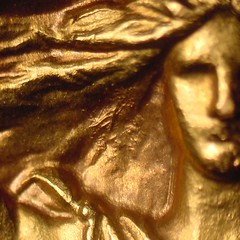
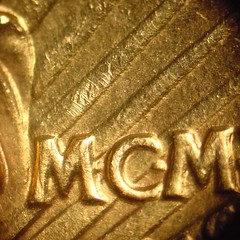
IS SKYJACKER D.B. COOPER ABOUT TO BE UNMASKED?
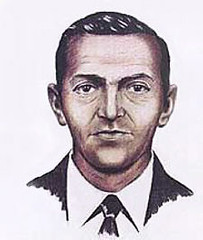 Funny that the recent edition of E-Sylum
included reference to D.B. Cooper. Because of my stroke I have been going
to therapy for the past two years. It is a free service offered by the
hospital. For the past year I have occasionally seen a woman who also uses
the facilities. We have talked. Now the short story.
Funny that the recent edition of E-Sylum
included reference to D.B. Cooper. Because of my stroke I have been going
to therapy for the past two years. It is a free service offered by the
hospital. For the past year I have occasionally seen a woman who also uses
the facilities. We have talked. Now the short story.Her neighbor was married to a man who was a member of the Air Force (retired), and local police force. The word is that she has been told that there is supposed to be an announcement around Nov. 24th about the "Case/Situation".
A Portland, OR attorney who has been doing research on the D.B. Cooper incident for quite awhile has stated that fingerprints from her dead husband, on file with the military and police departments, match the ones of D.B. Cooper. In addition, a photo of the man was picked out by a stewardess who was on the flight.
The F.B.I. has been keeping mum until recently. The man was known to have a gambling habit, but not much to support it. A son by an earlier marriage states that he went as a young boy on trips with his father that included stops at banks where he took money from safe deposit boxes. There is more, but the full facts could be out soon.
I have one question, however. If the suspect indeed spent notes from the ransom over the years, why haven't any been found? The only notes traceable to the ransom to date are the ones found in 1980 by an 8-year-old boy digging a fire pit along the Columbia River west of Vancouver.
With the Where's George serial number tracking site and years of FBI investigations, I would think that if "Cooper" managed to survive his parachute jump, then notes he spent would have been found before now. Perhaps the FBI has been sitting on evidence. Has anyone else heard anything about this case? -Editor
QUERY: MAVERICK SCRIP NOTE OF LAFAYETTE
The piece was sold by R. M. Smythe auction (#272 lot 3647 in Memphis 7/7/2007) from the Schingoethe collection as was cataloged in Tennessee. There is Lafayette, TN in Macon County but the local historian cannot find a record of Frank's Restaurant or the signature Reuben H. Frank during the period. Signature is weak.
I checked the obsolete books I have (SC, TN, AL, AK, MS, FL) and the GA obsolete website and did not find it. If you recognize it let me know. My email address is dennis@schafluetzel.org
QUERY: NUMISMATICALLY SIGNIFICANT CIRCULATION FINDS
Londoner David Powell writes:My own best experience was when I was a schoolboy c.1962/63 and found, on the ground outside a London Underground station in not exactly the most salubrious part of London, an 1853 Victoria farthing of the old, large copper type demonitized in 1869.
Best I have heard of for age is the story about a guy who, on going to a coin fair here in London, received a denarius of the Roman emperor Maximinus {235-238 AD} in his change from the taxi driver. The latter was obviously trying to pass it off as a five pence. I have also heard of someone getting a 1709 Queen Anne halfcrown in their change, although I can.t remember the details.
Just wonder whether you might care to invite your readership to contribute other similar stories as to what other unlikely pieces they have found in ordinary circulation?
THE BOOK BAZARRE
ALAN WEINBERG'S REPORT ON THE NOVEMBER 2008 BALTIMORE COIN SHOW
That evidently did not impact Bowers and Merena's auction of the recently discovered Sheldon 79 reeded edge "Good" 1795 large cent. Hardly an attractive piece (none are), it opened at $75K and closed at a rousing $350K plus 15% (totaling $402, 500) with phone and multiple floor bidders still over the $200K mark. It's quite an impressive figure , particularly when you realize the finest known VG-7 Sheldon 79 will be auctioned next September by McCawley-Grellman / Goldberg's in the sale of Dan Holmes' legendary large cent collection.
Doug Bird won the S-79 on the behalf of a large cent client. Why would a large cent collector pay $402,500 for a low grade Sheldon 79 when a "much finer" piece will sell next September? 'Cause that finer piece may be sought and bid upon by "Registry collectors" - that was the expressed rationale. These collectors may be prepared to pay more than "purist" large cent collectors.
George Fuld showed me the nearly finished manuscript for the forthcoming Peter Getz 1792 George Washington pattern book and it is impressive with numerous plates, many in color. Excellent research and some real surprises therein. Alan Mehgrig's graphic capability and George Kolbe's publication capabilities are participating in the project, a massive extension and updating of the late Jack Collins' Getz manuscript. This will be some book, appealing to pattern collectors, colonial collectors and George Washington collectors, among others.
ARTICLE RECOUNTS HOMEBOUND JOURNEY OF 1844-0 EAGLE
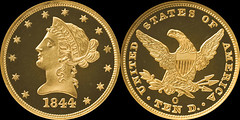 The airport is often about a clutching goodbye,
but one day in September it was about a homecoming.
The airport is often about a clutching goodbye,
but one day in September it was about a homecoming. That was the day New Orleans coin collector and dealer Paul Hollis walked through Armstrong International Airport in Kenner, flanked by an armed security guard and a State Police escort. Hollis walked through the airport, carrying in his hand a one-of-a-kind coin, sold at auction two years ago for a price that reached into seven figures.
.Well, traveling with a coin worth millions of dollars is, I mean it.s fun, but at the same time, you.ve got to be a little guarded,. Hollis said.
He arranged to have the coin shown here in New Orleans on loan, and flew to Florida to pick it up from an anonymous collector, then held it tightly in his hands for the next five hours.
.I'm not putting it in my sock,. he joked. .I'm not putting it in my briefcase. I'm going to carry this coin the entire way back to New Orleans..
A short drive later, from the airport to the French Quarter and the Old U.S. Mint, meant the coin was back in the Esplanade Avenue building where it was minted 164 years ago.
.To bring it back here, I couldn't help it. I got goosebumps,. Hollis said.
.I got goosebumps when I landed and when I walked into the New Orleans Mint, to know that that coin.s been brought back over a century and a half later. It was really, really, exciting for me..
Part of the desire for the coin is the mystery that surrounds it. Hollis says it.s so rare that initially it wasn't in any collector books. In 1911, there is one mention, when the secretary of state at the time, William Wooden, sold it at an auction.
But then it disappeared for 90 years.
.And not just off the market where it wasn't available for sale. Nobody really knew about the coin,. Hollis said.
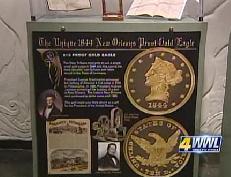

The 1844 "O" proof will be on display at the Old U.S. Mint until January 18, then it goes back to its owner in Florida, tightly in Paul Hollis. hands, the same way it got here.
To read the complete article, see: One-of-a-kind coin returns to New Orleans (http://www.wwltv.com/local/stories/wwl112008mlcoin.1d1d5c1d1.html)
NEWSPAPER ARTICLE PROFILES HERITAGE AUCTION GALLERIES
They are co-chairmen of Heritage Auction Galleries, a Dallas-based auction house with sales of more than $700 million this year. Ivy is a Fort Worth lawyer.s son who graduated from Arlington Heights High. Halperin is an East Coast transplant who, like his business partner, left college without a degree.
They used to be rival coin dealers but merged their operations in 1982 and around 2001 began putting comic-book and movie-poster auctions online. The first movie poster auction, in November 2001, brought in about $960,000. By the fourth auction, sales were $5.2 million. Heritage Auction now occupies more than four floors of wood-paneled office space near Oak Lawn and Maple avenues and has about 375 employees, including experts who appear on PBS. popular Antiques Roadshow. Heritage still sells coins but now also auctions stamps, fine art, movie posters, comic books, jewelry and Americana.
Heritage.s sales put it third in the world, behind Sotheby.s and Christies auction houses, spokeswoman Kelley Norwine said.
"I just love being a coin dealer," said Halperin, 56, a twice-published novelist whose books deal with cryonics and a foolproof lie detector that changes not just the justice system but also society. "I love being in business."
He, Ivy and Greg Rohan, another childhood coin maven and now Heritage president, occupy 17th-floor quarters atop the Uptown building. Visitors must wear ID tags and sign in with an attendant who sits behind glass off the black-and-white marble-floored lobby.
To read the complete article, see: Entrepreneurs have built big Dallas auction house (http://www.star-telegram.com/dallas_news/story/1053446.html)
THIRD-PARTY COIN SLABBING IN EUROPE
"Without question this is one of the most impressive sales of ancient coins in recent memory," says David Vagi, Director of NGC Ancients. "The quality is outstanding, and there are some important rarities that will attract serious bidding."
Relatively new to the international collectible coin market, independent third-party certification has become a major factor in the U.S. in determining a coin's value by evaluating and documenting its condition. According to industry resources, the collectible coin market has experienced a near 20-year growth cycle virtually unaffected by broader economic cycles. As a result, coin collectibles have blossomed into a $10 billion dollar industry in the United States. Coin certification is credited for much of that growth.
As coin certification gains traction in Europe, a similar trend is expected and may already be impacting the market based on the recent sale of an NGC certified Russian coin that sold for $2.4 million, a record for a world coin. In May, the world coin Millenia collection, featuring all NGC certified coins, produced record prices realized and overall sales. Both auction and coin certification experts expect the NGSA auction to set several records and establish new benchmarks for graded European coins. Industry experts are anticipating the event to gauge the resiliency of the industry in light of recent global economic events.
The 300 NGC certified coins in the auction include ancient specimens from the Roman Empire, the Roman Imperatorial, the Roman Republic, Ancient Greece and the Celtic region. Other examples from the 1600s to early 20th century originate from Albania, Germany, Austria, Belgium, Bolivia, Brazil, Denmark, Spain, France, England, Greece, Holland, Italy, Poland, Russia and Switzerland.
To read the complete article, see: Prestigious European Coin Auction Looks to U.S. Experts for Success (http://www.marketwatch.com/news/story/
Prestigious-European-Coin-Auction-Looks/story.aspx?
guid=%7BA017F2A7-8387-4C8F-9579-09A025C0D361%7D)
PRESIDENTIAL DOLLARS VENDED FROM U.S. MINT TRUCKS
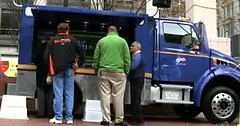 At first I thought this was a joke, but here are
the pictures. A big green truck that dispenses presidential dollar coins
for your paper currency up (to $20) in vending machines built into the
side of the truck. The article stated the truck was sent there by the U.S.
Mint to Portland, Oregon. Again, I questioned this, but there it was, the
mint's seal painted on the truck.
At first I thought this was a joke, but here are
the pictures. A big green truck that dispenses presidential dollar coins
for your paper currency up (to $20) in vending machines built into the
side of the truck. The article stated the truck was sent there by the U.S.
Mint to Portland, Oregon. Again, I questioned this, but there it was, the
mint's seal painted on the truck. The article lists where the truck will be stationed. It travels from what looks like shopping center to shopping center with three hour layover to dispense its dollars. The public's comments ranged all over the spectrum.
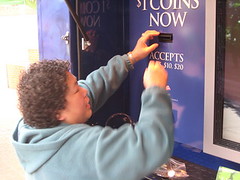 Some chastised the presidential dollar coins
because the motto "In God We Trust" was not on the coins (when it is
located on the edge). Another complained about losing the paper dollars
because now he would have to put fives in strippers'
G-strings.
Some chastised the presidential dollar coins
because the motto "In God We Trust" was not on the coins (when it is
located on the edge). Another complained about losing the paper dollars
because now he would have to put fives in strippers'
G-strings.People!
To read the complete article, see: Mint pushes new dollar coin in Portland (http://www.oregonlive.com/news/index.ssf/2008/11/
the_new_dollar_coin_another_le.html)
PRESIDENT BUSH SURPRISES FOUR WITH PRESIDENTIAL CITIZENS MEDALS
 President George W. Bush pulled a rare surprise
at a White House awards ceremony on Monday, handing out medals to four
people who thought they were there just to help out.
President George W. Bush pulled a rare surprise
at a White House awards ceremony on Monday, handing out medals to four
people who thought they were there just to help out. After presenting almost 20 medals for achievements in the arts and humanities, Bush unexpectedly awarded the Presidential Citizens Medal to Bruce Cole, chairman of the National Endowment for the Humanities; Dana Gioia, chairman of the National Endowment for the Arts; Adair Margo, chairman of the President.s Committee on the Arts and Humanities; and Bob Martin, former director of the Institute of Museum and Library Services. A fifth surprise recipient, Anne Radice, didn.t attend and was to receive her medal later.
.As president, I rarely have the opportunity to surprise anybody,. Bush began. .It is tough to be stealthy with a security detail that comprises a 20-car motorcade. That makes me especially pleased to present the President.s Citizens Medal to four outstanding . and unsuspecting . leaders in the arts: Bruce Cole, Dana Gioia, Adair Margo, and Bob Martin.
.Please do not rush the stage,. he added. .Remember the big security detail?.
To read the complete article, see: Bush Surprises Four With Presidential Citizens Medals (http://blogs.wsj.com/washwire/2008/11/17/
bush-surprises-four-with-presidential-citizens-medals/)
For more information on the Citizen's Medal, see: Citizens Medal.com (http://www.citizensmedal.com/)
MUSEUM ACQUIRES MEDAL OF NUMISMATIST SIR JOHN EVANS
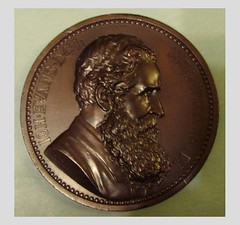 An expert on antique coins and descendant of
John Dickinson has been honoured in the centenary year of his death.
Archivists at The Apsley Paper Trail, the site of Mr Dickinson's mills and
the heart of the papermaking industry's history, have acquired a
commemorative medal of Sir John Evans.
An expert on antique coins and descendant of
John Dickinson has been honoured in the centenary year of his death.
Archivists at The Apsley Paper Trail, the site of Mr Dickinson's mills and
the heart of the papermaking industry's history, have acquired a
commemorative medal of Sir John Evans.The distinguished numismatist was the nephew and son-in-law of John Dickinson, who joined the company in 1840 and then managed the firm until his retirement.
The Paper Trail's Michael Stanyon, who recently contributed to a book about John Evans' role in the paper industry and the local community, described him as a 'remarkable man'.
In addition to Sir John's contribution to the paper industry and the local community, he was especially distinguished as an antiquary and numismatist, a collector of ancient objects and coins.
He was president of the Numismatic Society of London, now the Royal Numismatic Society, between 1885 to 1892, and was also a published author. His books, standard in their respective departments, were The Coins of the Ancient Britons (1864), The Ancient Stone Implements, Weapons and Ornaments of Great Britain (1872), and The Ancient Bronze Implements, Weapons and Ornaments of Great Britain and Ireland (1881).
It was to mark his long and distinguished service to the Society that the commemorative medallion was created. It is available to view at The Paper Trail's Visitor Centre at Frogmore Paper Mill in Apsley.
To read the complete article, see: On the amazing trail of Sir John (http://www.hemeltoday.co.uk/heritage/On-the-amazing-trail-of.4715685.jp)
A GREAT YEAR FOR TREASURE HUNTERS
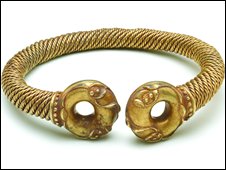 There has been a significant rise in the number of
valuable artefacts found by amateur treasure hunters in Britain.
There has been a significant rise in the number of
valuable artefacts found by amateur treasure hunters in Britain.
The British Museum says the number of finds containing gold and silver rose by 12.6% to 749 in the last 12 months.
The most valuable discovery was a rare Iron Age necklace found near Newark in Nottinghamshire and worth #350,000.
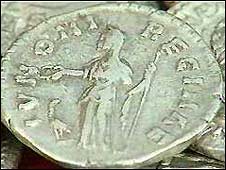 Experts say the rise is due to the growing
popularity of metal detectors and the legal obligation on treasure hunters
to report their finds.
Experts say the rise is due to the growing
popularity of metal detectors and the legal obligation on treasure hunters
to report their finds. The new figures were revealed in the British Museum's annual report of treasure.
It said the total number of finds was 1,257, which included objects from 2005 and 2006 that have now passed through the treasure process.
In 2001, the report documented just 200 treasures.
Culture minister Barbara Follett said: "The treasures of the past that are found in the fields, farms and fells across the United Kingdom are vital pieces in the jigsaw puzzle of our history."
She also singled out former Rolling Stones bassist Bill Wyman as an "obsessive treasure finder".
Mr Wyman has a section dedicated to archaeology on his website.
To read the complete article, see: Busy year for UK treasure hunters (http://news.bbc.co.uk/2/hi/uk_news/7736759.stm)
Dick forwarded this link to a set of pictures of some of the found items: In pictures: Treasure galore (http://news.bbc.co.uk/2/hi/in_pictures/7738208.stm)
ANCIENT CELTIC COIN CACHE FOUND IN NETHERLANDS
"It's exciting, like a little boy's dream," Paul Curfs, 47, said Thursday after the spectacular find was made public.
Archaeologists say the trove of 39 gold and 70 silver coins was minted in the middle of the first century B.C. as the future Roman ruler Julius Caesar led a campaign against Celtic tribes in the area.

Curfs said he was walking with his detector this spring and was about to go home when he suddenly got a strong signal on his earphones and uncovered the first coin.
"It was golden and had a little horse on it . I had no idea what I had found," he said.
After posting a photo of the coin on a Web forum, he was told it was a rare find. The following day he went back and found another coin.
"It looked totally different . silver, and saucer-shaped," he said. Curfs notified the city of his find, and he and several other hobbyists helped in locating the rest of the coins, in cooperation with archaeologists.
Nico Roymans, the archaeologist who led the academic investigation of the find, believes the gold coins in the cache were minted by a tribe called the Eburones that Caesar claimed to have wiped out in 53 B.C. after they conspired with other groups in an attack that killed 6,000 Roman soldiers.
To read the complete article, see: Ancient Celtic coin cache found in Netherlands (http://news.yahoo.com/s/ap/20081113/ap_on_sc/
eu_netherlands_celtic_coins_2)
HOW TO SPOT A FAKE POUND COIN
That #1 coin in your pocket could be worthless.
The number of fake pound coins in circulation has doubled in the past five years and one in every 50 is now counterfeit.
It's illegal to make or use counterfeited coins and the Royal Mint says people must hand them in if they think they have one. But how can you tell?
It all depends on the quality of the counterfeit, but key signs include a poorly defined ribbed edge, the wrong typeface and an indistinct design or bust of the Queen. A fake can also be slightly different in colour.
"Current fakes are what we call 'soapy' in the coin business," says Garry Day, who works for a leading coin dealer, AH Baldwin.
"This means the marking and detail on them, like the queen's head, are blurred and not very distinct."

Another way to identify a fake is to check the alignment of the coin. Hold it so the Queen's head is upright and facing you - when you turn the coin over, the pattern on the reverse should also be upright. Fakes can often be at an angle.
The Royal Mint's online design portfolio can also be used to easily identify what's genuine and what's not. Since they were introduced in 1983, the design on the reverse of the coins has changed every year.
Often the year and the design do not correspond on a fake. Also, the Latin motto on the edge of the coin should correspond to the right year. A simple test at any automated vending machine can also identify a suspect coin. A lot of counterfeit coins are rejected, often leaving you grappling to find another coin in your purse or pocket.
But ultimately, how easy it is to identify a fake comes down to its quality. The good news is the fakes are getting worse, according to some experts.
"Quality is definitely dropping and fakes are now quite obvious, even to the untrained eye," says Mr Day, who has been studying the problem.
To read the complete article, see: How do you spot a fake pound coin? (http://news.bbc.co.uk/2/hi/uk_news/magazine/7628930.stm)
ARGENTINA.S COIN SCARCITY LEADS TO BLACK MARKET COIN TRADE
.The problem is that the banks, bus companies and toll companies that soak up most of the loose change in circulation have discovered that reselling the coins is a tremendously lucrative business with a profit margin of up to 8% tax free, because it is an illegal trade on the black market,. Miguel Calvette told Time magazine. Calvette is a spokesperson for the Association of Chinese Supermarket Owners, which is speaking out against the alleged coin racket on behalf of some 4,000 shops run by Chinese natives in Argentina.
It.s at the point where Buenos Aires housewife Laura Daniel has .to hold her purse steady when shopping, because if the shop owner hears coins clinking inside, he.s going to demand I pay with them,. she told Time. .And it could get nasty, because I need the loose change for the bus..
To read the complete article, see: Argentina.s Coin Scarcity Leads to Illicit Numismatic Trade (http://www.findingdulcinea.com/news/Americas/2008/November
/Argentinas-Coin-Scarcity-Leads-to-Illicit-Numismatic-Trade.html)
UNCERTAIN ECONOMY BOOSTS WORLD MINTS' GOLD PRODUCTION
Perth Mint sales and marketing director Ron Currie said the unprecedented demand had forced the Mint to cease orders until January, with staff working seven days a week, 24-hour days, over three shifts to meet orders. He said Europe was leading the demand, with Russia, Ukraine, Middle East and US all buying . making up 80 per cent of its sales. One European client purchased 30,000 ounces for $33 million.
.We have never seen this before and are working right at capacity. And we are seeing it from clients in the shop buying one ounce, right up to 30,000 ounces from overseas clients,. Mr Currie said.
To read the inside story from Perth Mint officials, click on: Perth Mint has been forced to suspend orders (http://www.dgcmagazine.com/blog/?p=755)
HILLARY CLINTON PHOTOGRAPHED IN SHELDON'S HUMAN PHYSIQUE BOOK?
James Higby writes:But something doesn't quite add up. Higby notes:
To read the complete article, see: A Closer Look at William H. Sheldon (http://www.innerexplorations.com/psytext/acloser.htm)
FEATURED WEB PAGE: CANADIAN COIN, CANCELLED (WAFFLED) BY MISTAKE?
This week's featured web page is an article by Bill Snyder on an unusual Canadian loon dollar "waffled" for destruction.From the web site:
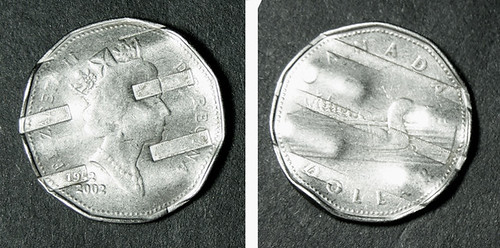
www.littlemistakes.com/waffles/Canada/
